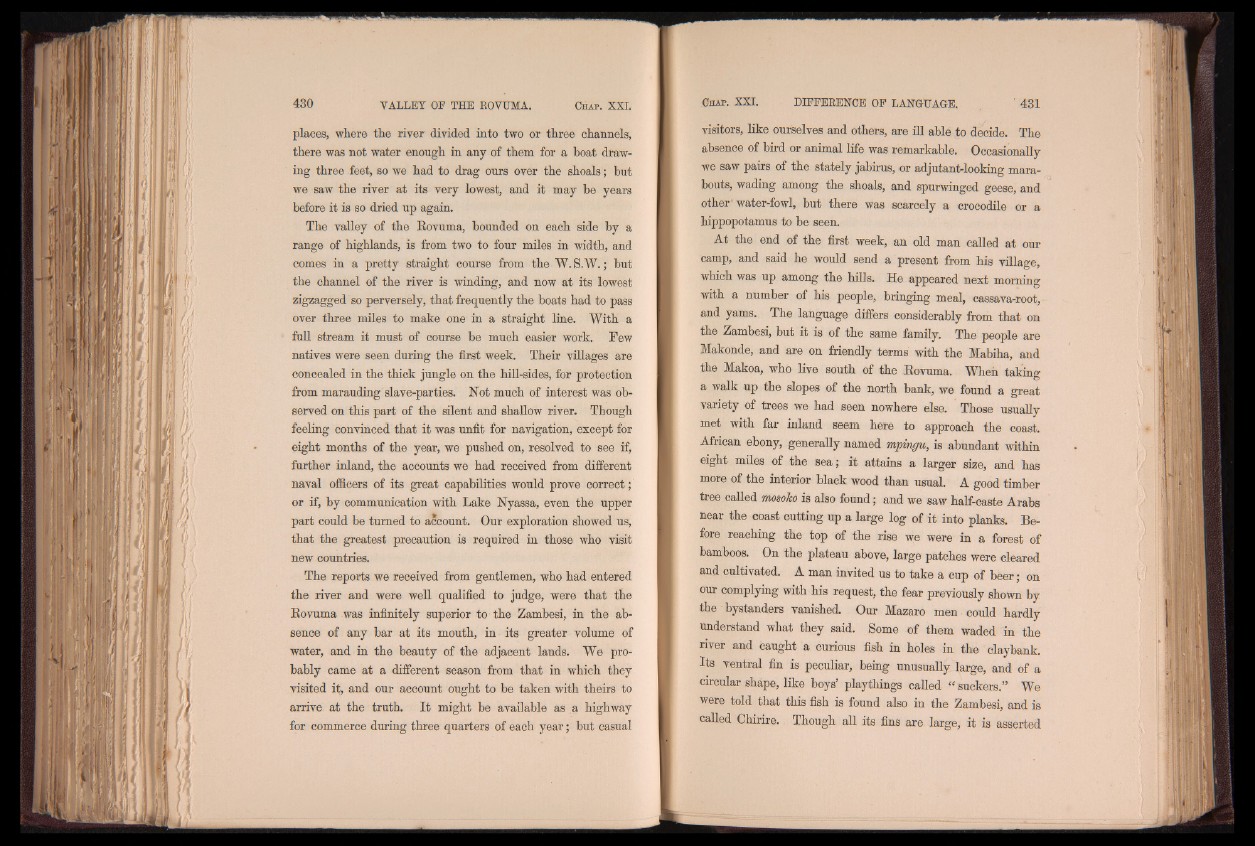
places, where the river divided into two or three channels,
there was not water enough in any of them for a boat drawing
three feet, so we had to drag ours over the shoals; but
we saw the river at its very lowest, and it may be years
before it is so dried up again.
The valley of the Eovuma, bounded on each side by a
range of highlands, is from two to four miles in width, and
comes in a pretty straight course from the W.S.W.; but
the channel of the river is winding, and now at its lowest
zigzagged so perversely, that frequently the boats had to pass
over three miles to make one in a straight line. With a
full stream it must of course be much easier work. Few
natives were seen during the first week. Their villages are
concealed in the thick jungle on the hill-sides, for protection
from marauding slave-parties. Not much of interest was observed
on this part of the silent and shallow river. Though
feeling convinced that it was unfit for navigation, except for
eight months of the year, we pushed on, resolved to see if,
further inland, the accounts we had received from different
naval officers of its great capabilities would prove correct;
or if, by communication with Lake Nyassa, even the upper
part could be turned to account. Our exploration showed us,
that the greatest precaution is required in those who visit
new countries.
The reports we received from gentlemen, who had entered
the river and were well qualified to judge, were that the
Eovuma was infinitely superior to the Zambesi, in the absence
of any bar at its mouth, in its greater volume of
water, and in the beauty of the adjacent lands. We probably
came at a different season from that in which they
visited it, and our account ought to be taken with theirs to
arrive at the truth. I t might be available as a highway
for commerce during three quarters of each year; but casual
visitors, like ourselves and others, are ill able to decide. The
absence of bird or animal life was remarkable. Occasionally
we saw pairs of the stately jabirus, or adjutant-looking marabouts,
wading among the shoals, and spurwinged geese, and
other’water-fowl, but there was scarcely a crocodile or a
hippopotamus to be seen.
At the end of the first week, an old man called at our
camp, and said he would send a present from his village,
which was up among the hills. He appeared next morning
with a number of his people, bringing meal, cassava-root,
and yams. The language differs considerably from that on
the Zambesi, but it is of the same family. The people are
Makonde, and are on friendly terms with the Mabiha, and
the Makoa, who Eve south of the Eovuma. When taking
a walk up the slopes of the north bank, we found a great
variety of trees we had seen nowhere else. Those usually
met with far inland seem here to approach the coast.
African ebony, generaUy named mpingu, is abundant within
eight miles of the sea; it attains a larger size, and has
more of the interior black wood than usual. A good timber
tree called mosoko is also found; and we saw half-caste Arabs
near the coast cutting up a large log of it into planks. Before
reaching the top of the rise we were in a forest of
bamboos. On the plateau above, large patches were cleared
and cultivated. A man invited us to take a cup of beer; on
our complying with his request, the fear previously shown by
the bystanders vanished. Our Mazaro men could hardly
understand what they said. Some of them waded in the
river and caught a curious fish in holes in the claybank.
Its ventral fin is peculiar, being unusually large, and of a
circular shape, like boys’ playthings called “ suckers.” We
were told that this fish is found also in the Zambesi, and is
caEed Chirire. Though all its fins are large, it is asserted